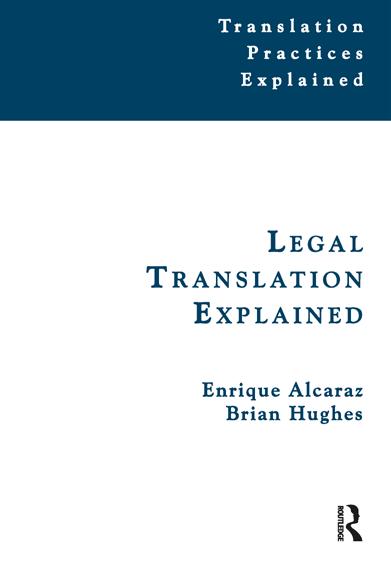
4 minute read
A legal translation book reviewed
'Legal Translation Explained'
by Enrique Alcaraz and Brian Hughes (London and New York: Routledge, 2014)
Advertisement
reviewed by Dakshayani Shankar Sthipam
In this textbook/manual, Universidad de Alicante professors Alcaraz and Hughes serve up a wealth of information for translation students and practitioners alike.

Cover of 'Legal Translation Explained', Alcaraz and Hughes, copyright 2014, Routledge, reproduced by permission of Taylor & Francis Books UK
Covering translations from English into French, Spanish and German, they nudge readers past elaborate abstraction to teach them how to translate the English ‘legalese’ of the Anglo-American system of law used here in Australia and New Zealand (as well as throughout most of North America and the British Isles).
Although the book hasn’t been updated since 2014, the authors’ styling of chapters— whereby each builds upon those that come before it—allows translators to gather that legal translation requires a balance between innovation and precedence. It is this precise, gem-like quality of the book that continues to sustain its presence in the industry. The authors strategically divide the book into eight chapters within four thematic blocks, ranging from the linguistics of legal English to translation methods suitable for this context, with little reminders of how the legal system operates.
In Chapters 1 and 2, the oscillation between technical, semi-technical and everyday language demonstrates how tricky it can be to locate the most suitable sense for a legal context. For example, the ‘breaking’ of a law can represent both ‘breach’—concerning contracts—and ‘infringement’—failure to abide by a local bylaw (page 34).
Some readers may be confounded by the authors’ meticulousness in exploring what are often only slight variations in the meaning of a term. However, as Chapters 3 and 4 ease readers into the cultural background of the British and American legal systems, it becomes clear that in order to understand them, translators first have to grasp the complexity of legal English.
The authors discourage translators from being overly hasty in assuming all legal systems are composed of the same or similar powers and can be translated as such. For example, they describe how the British Supreme Court, the country’s final court of appeal, possesses different powers from the American Supreme Court (page 58).
This is where the authors’ talent for deconstruction dots the pages, as they stress the necessity for students and practitioners to develop cultural awareness. Despite giving English-to-target language translations, they point out that ‘localised’ equivalents can continue to change over time, so we need to keep up with the evolution of terminology in order to avoid making serious mistakes during assignments.
This innate sense of prudence slithers into Chapters 5 and 6, as the authors decode an array of genres such as deeds, powers of attorney, insurance policies and certificates. They don’t hold back here at all; they emphasise how to approach a university degree translation in comparison to a statute, how to preserve the genre conventions, and what happens when the target and source languages’ genre conventions don’t match up.
At times, the introduction of genre after genre—followed by expert analysis—can seem daunting, particularly for novices to the industry like myself. However, it enables us to deduce that sticking to a genre’s conventions is but one aspect of the larger task of locating a compromise between the imperfectly matched genre conventions of two cultures.
Although I found each chapter relevant to the T&I industry, I would pinpoint the final two as the most beneficial to practitioners. In these chapters the authors step back from analysing the legal system to put forward the idea of dynamic equivalence and ‘indirect translation’, advising translators to ‘subvert’ an original’s ‘syntactic’ into a new version (page 191). ‘The essence of the method is to produce on the target reader an equivalent effect to that produced by the source text … the translator should, as Hamlet puts it, “by indirections find directions out”’ (page 180). This emphasis on cultural mediation prepares translators to rely more on their intuition than expected. If the publisher considers further editions, I believe this concept could be accentuated earlier in the book.
As I look towards incorporating legal translation into my career, I can see that this textbook will continue to help me cut through the jargon. While it is restricted to the Anglo-American legal system and three European languages, the layout of the terms may help practitioners working with other languages solidify their knowledge of the legal world. A treasure trove of a textbook, it is one that students and practitioners will find useful for decades to come.
Author bio:
Dakshayani Shankar Sthipam is pursuing a Master of Translation Studies degree at the University of Western Australia while working in communications. Born in Kuala Lumpur, Dakshayani has been moving between languages (Tamil, Malay, Mandarin and English) from a young age. Her family migrated to Perth, and she developed a passion for French in high school. She holds a BA in journalism, French and German (New York University) and has reported for the ABC, NBC and CNN. Working as a journalist after returning to Perth Dakshayani missed studying languages, so she enrolled at UWA. She works primarily in French, German and English, but aims to add Tamil and Malay into the mix soon, and to commence a PhD in French and translation studies on completion of her MA.
NOTE:
'Legal Translation Explained' is one of the Translation Practices Explained series of twenty-five T&I-related books.










